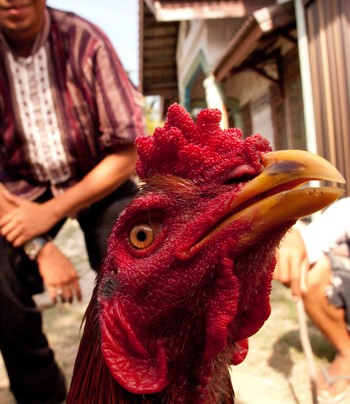Bali is famous for its cockfighting, but Acehnese men love their fighting birds too
Scott Naysmith
A fighting cock is fawned over by owner and associates. While one ofmany, this bird is prized among the rest and sleeps in the same room asthe man on the left.Scott Naysmith |
Fighting between cocks occurs instinctively. Less natural is the exploitation and institutionalisation of this innate animosity. Cockfighting, which provides a form of livelihood and entertainment to both breeders and onlookers, remains popular in many parts of the world with a history of domesticated fowl, and it is almost exclusively men who appropriate the antagonism between cocks for gain and enjoyment.
Formalized cockfighting is believed to have originated in Southeast Asia over 2500 years ago. But enterprising individuals, separated by history and a vast geography, have long subjected cocks to such contests. Cockfighting has been described as integral to the Dominican identity. In Ireland, and many other European countries, fighting fowl trade hands for hundreds of Euros. Though stigmatised and banned during Suharto’s reign as un-modern and un-Islamic, cockfighting has a wide following in Indonesia, predating Islamic expansion from the Arabian Peninsula to the archipelago.
Clifford Geertz, an American anthropologist, wrote the text on culture and cockfighting in Indonesia from his experience of living in a Balinese village in the late 1950s. For Geertz, the cockfight was a colourful manifestation of culture – ‘a Balinese reading of Balinese experience, a story they tell themselves about themselves’. While some have critiqued Geertz for essentialising the significance of the cockfight in Balinese culture, his essay, Deep Play: Notes on the Balinese Cockfight, remains seminal to our understanding of the interaction between people and birds.
 |
Birds that win a fight are often wounded in the process. Here, a full-time attendant applies a Chinese salve to aveteran fighting cock’s wounds after the bird’s last victorious bout.Scott Naysmith |
Geertz describes the Balinese cockfight as a public spectacle. In Aceh, where these photos were taken, bet-on fights are banned by Islam. Despite these restrictions, fighting cocks, marked by featherless patches and cooped in bamboo cages, are not uncommon in rural communities. And while bred and reared in the public gaze, the fights often take place in the forest or at the back of farms, away from view and religious censure.
 |
When wounds become infected minor surgery is required. Here a ‘tumor’, the result of a blow to the head, isexcised by razor.Scott Naysmith |
 |
Cock owner and bird look on at a makeshift opponent from the same flock.Scott Naysmith |
Geertz saw the cock as an extension of the cock owner – a public reflection of himself. And far from simply a duel between two birds, Geertz found the cockfight to be a contest between men; a symbolic yet public contestation of masculinity and status.
It would then follow that cock grooming and care is a form of self-maintenance. Routinely cleaned, massaged and medicated between bouts, the lives of fighting cocks straddle luxury and brutality. The juxtaposition between intimate care and violent competition is striking.
 |
Not an uncommon scene in the family’s yard, two cocks display aggression and manage to delay a young boyfrom dressing.Scott Naysmith |
 |
Entirely consumed by the fight, cocks obsess on their opponent, with little consideration for outside distraction.Scott Naysmith |
Even the best fighting cocks will eventually succumb to a more skilled opponent or be retired by their owners. Never knowing when a fatal blow will strike down a champion fighter, cock owners often nurture a stable of birds in anticipation of this succession.
 |
Manipulating their necks in an attempt to dominate opponents, cocks grapple – a common strategy when not atdirect blows.Scott Naysmith |
Untested cocks are first pitted against birds from the same stable before competition with rivals. While these debut fights stop short of fatal blows, they provide an indication to owners of how their birds will perform when money and status are at stake. The battling birds in these photos are from such a contest. The images reveal that far from simply cruel and brutal, cockfighting exhibits an intimate relationship between men and their birds.
Scott Naysmith (s.naysmith@lse.ac.uk) is a doctoral candidate at the London School of Economics and Political Science and is supported by the Trudeau Foundation.












